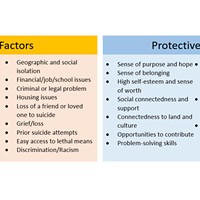'The Disparity'
Analyzing the social determinants of health in Humboldt
By Thadeus Greenson [email protected] @ThadeusGreenson[
{
"name": "Top Stories Video Pair",
"insertPoint": "7",
"component": "17087298",
"parentWrapperClass": "fdn-ads-inline-content-block",
"requiredCountToDisplay": "1"
}
]
Fifteen pages into Humboldt County's Community Health Improvement Plan is a blunt summation: "Humboldt County experiences a higher death rate overall when compared to California, and Humboldt rates for nearly all the leading causes of death are two to three times higher than that of the state."
It's easy to read the line, look over the report's grim data and wonder: What are we doing wrong? The short answer is plenty, but the full answer is complex, as indicated by the report's next line: "The disparity is similar in many other poor, rural communities like ours across the nation."
Health officials increasingly believe the root cause of such disparities, and Humboldt County's generally poor health, lie in what are known as social determinants of health. While none of these factors — education, healthcare access and quality, neighborhood and built environment, economic stability, and social and community context — directly dictates the personal choice of whether to smoke a cigarette or go for a run, to reach for a salad or a Happy Meal, they collectively impact community health and obstacles that must be overcome to maintain personal physical and mental health.
Let's take a look at what they look like in Humboldt County:
Education
The idea here is that the more education someone has, the better equipped they generally are to make informed choices about their health. After all, what good does nutritional content labeling do if someone can't read it?
Here it would seem Humboldt County is doing fairly well. According to the U.S. Census, 91 percent of Humboldt residents age 25 and older have a high school degree compared to 84 percent of Californians. When it comes to college degrees, we lag some, with 31 percent of Humboldt County residents age 25 and older having obtained a bachelor's degree compared to 36 percent statewide. About 13 percent of Humboldt County adults are functionally illiterate, compared to 21 percent of Americans and 29 percent of Californians.
Health Care Access and Quality
This one is a bit harder to gauge but the limited data and anecdotal reports indicate Humboldt County lags behind California as a whole. According to the U.S. Census, 8 percent of Humboldt County residents don't have health insurance, compared to 6 percent statewide. Additionally, Humboldt County's resident-to-primary-care-giver ratio lags behind the state's, with 1,590 residents per primary care provider in Humboldt, compared to 1,240 statewide.
According to Let's Get Healthy California, 36 percent of Humboldt County residents don't have sufficient access to healthcare, which is probably attributable to both a shortage of providers and the sprawling nature of the county, which poses transportation challenges in outlying areas. There is also a well-documented shortage of specialty providers countywide, from orthopedists to psychiatrists.
Neighborhood and Built Environment
This is a far-reaching category that includes everything from safe housing and available transportation to access to safe drinking water and nutritious foods. As such, it's a bit hard to quantify, though the county's health improvement plan does have some notable data points.
It points out that according to the Census, 62 percent of renters and 40 percent of homeowners in Humboldt were cost burdened, paying more than 30 percent of their income on housing. "As a result of the limited housing market with few affordable options, people with the lowest incomes may end up living in poorly maintained housing that exposes them to health and safety risks," the plan states, noting that a quarter of Humboldt County households reported living with at least one "severe" housing problem, such as an incomplete kitchen or inadequate plumbing.
Whether it's poverty or living in food deserts where markets aren't easily accessible, food insecurity is also a pervasive problem locally. Here, 17 percent of the population and 22 percent of children experienced food insecurity in 2018, according to the California Department of Public Health. Organizations working to address the problem say it's only grown worse.
"There is strong evidence that access to supermarkets and the ability to afford healthy foods connects to a lower rate of obesity, diabetes or diet related deaths," the county health plan states.
Economic Stability
While an estimated 12 percent of Californians live below the federal poverty line of $30,000 in annual income, that number jumps to 20 percent in Humboldt. Throw in high housing costs, and many Humboldt County households are struggling to make ends meet, which is further evidenced by the more than 60 percent of local students who qualify for free and reduced lunch at school.
Add in the estimated 1,749 Humboldt County residents who are homeless, 79 percent of them unsheltered, and it's clear we have a poverty problem that likely significantly drives poor health outcomes.
Social and Community Context
This is difficult to quantify, though Humboldt County's high rates of childhood trauma, substance use and domestic violence are indicators of a frayed social fabric.
Perhaps the biggest red flags here are Humboldt County's rates of children in foster care (nearly triple that of the state with 13.5 per 1,000 compared to 5.5) and that we have the highest proportion of children who have experienced two more traumatic childhood experiences (29 percent, which is nearly double the national rate) of any California County.
Notably, none of these social determinants or adverse health outcomes are evenly distributed across all Humboldt County demographics. For example, Native community members — who have experienced disproportionate generational trauma and systemic marginalization — suffer far worse outcomes than the overall population.
"Native Americans in Humboldt County will die an average of 12 years sooner than Caucasians, and their rates of infant mortality, motor vehicle fatalities, cardiovascular disease, liver disease, drug-related deaths and diabetes-related deaths are far higher than the total Humboldt County rates," Humboldt's health plan states.
What the data underlying these determinants of health make clear is that while we can encourage healthy choices — moderating alcohol intake, quitting smoking, getting some exercise, eating more vegetables — creating a healthier Humboldt will require systemic change that addresses poverty, the cycle of childhood trauma and ensures everyone access to affordable housing.
Thadeus Greenson (he/him) is the Journal's news editor. Reach him at (707) 442-1400, extension 321, or [email protected].
more from the author
-
Deputy Shoots Cutten Shooting Suspect
- Apr 25, 2024
-
Arcata Lowers Earth Flag as Initiative Proponents Promise Appeal
- Apr 25, 2024
-
Officials Weigh in on SCOTUS Case's Local Implications
- Apr 25, 2024
- More »
Latest in News
Readers also liked…
-
Through Mark Larson's Lens
A local photographer's favorite images of 2022 in Humboldt
- Jan 5, 2023
-
'To Celebrate Our Sovereignty'
Yurok Tribe to host gathering honoring 'ultimate river warrior' on the anniversary of the U.S. Supreme Court ruling that changed everything
- Jun 8, 2023


































